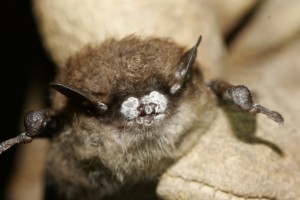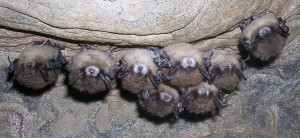
You never know when a story idea will land on your doorstep—or in your mailbox. When award-winning journalist Michelle Nijhuis learned about caver and microbiologist Hazel Barton from a friend, she had no idea Barton would be her ticket into a science story she had been itching to tell, about a fungus that is ravaging bat populations in the U.S. with devastating speed—and about scientists’ scramble to understand and thwart the disease’s spread. Getting the story involved some scrambling of her own, including through some of the nation’s most iconic caves. “Crisis in the Caves” (published online as “What is Killing the Bats?“) appeared in Smithsonian in July/August, 2011.
Here, Nijhuis tells TON co-founder Siri Carpenter the story behind the story. (This interview has been edited for length and clarity.)
How did this story idea come about?
It was really serendipity, where a great character and an interesting topic bumped into each other. Usually I’ll move either from topic to story, or from character to larger topic, but in this case those elements developed on parallel tracks. I first heard about the caver and microbiologist Hazel Barton through a Christmas letter that I got from a friend of mine who is a caver, and who had met Hazel at Carlsbad Caverns. At the time, I had no idea that Hazel was working on white-nose syndrome, but I thought, “Hmmm, she seems like an interesting profile,” and I wrote her name down on my idea list, which is just a messy Word document that I keep of potential stories and pieces of stories.
At the same time, I was following the news about the spread of white-nose syndrome in the Northeast, and I was trying to find a way to write about it that would convey the seriousness of the problem but wouldn’t drive readers away. I hadn’t found a way to do that yet.
Toward the end of 2009, while I was looking for some new ideas to pitch, I saw Hazel’s name on my list, and called her to introduce myself and ask what she was up to. She told me that she hadn’t had much time to continue her work at Carlsbad Caverns, partly because she and her lab had been almost completely occupied with work on white-nose syndrome. She’s based in Kentucky, at Northern Kentucky University, and white-nose syndrome had not yet been discovered in the state. So she was spending a lot of her time sampling the hair and skin of healthy bats, looking for natural compounds that might help them resist white-nose syndrome. I was thrilled, because I thought I might have the perfect ingredients for a story—not only an important, timely issue, but also a terrific central character whose work pointed toward some possible solutions.
Did you have any reservations?
One of the reasons I waited for so long to write about white-nose syndrome, and one of the reasons I was so excited to find Hazel, is that extinction—or near extinction—is such a difficult thing to write about. It’s so important, but everyone feels like they’ve heard about it before, and since there are rarely any easy solutions, extinction stories are almost unavoidably depressing. I can’t blame people for choosing to read about other things in the dentist’s office, or over their morning coffee.

A particular challenge with Smithsonian is that the magazine tends to be drawn toward charismatic megafauna—while bats are fascinating, a lot of people don’t find them charismatic, and they’re definitely not megafauna. And like most general-interest magazines, Smithsonian doesn’t get excited about “doom and gloom” environmental stories—they will tackle serious environmental issues, but they like to find a positive or at least potentially positive angle.
I couldn’t do anything about the charismatic megafauna problem, but I thought that Hazel’s work might give the story some measure of realistic hope. I started out thinking that the hopeful element might be that Hazel—and her colleague Brooke Slack, who was surveying bat populations for white-nose syndrome—succeeded in keeping the disease out of Kentucky, but white-nose syndrome turned up in Kentucky just as I was completing work on the story. In the end, I found a bit of hope just by getting up close to the epidemic, and spending time with people who were starting to understand it. There is and will be huge damage to bat populations from white-nose—there’s no getting around that—but there is texture to the epidemic, and these researchers are working hard to take advantage of that.
What were your first steps in developing this story?
I spoke with Hazel, found out about her work, and made sure that she was willing to spend time with me for the story. She was used to dealing with the media—her caving and her previous microbiology work had been featured in several stories—so she knew what she was getting into, and she readily agreed. Then I spoke with my editor, Laura Helmuth. I pitched it as a story about Hazel’s work to contain white nose syndrome and keep it out of Kentucky.
Laura was really important and helpful to the development of the pitch, suggesting several elements that would make it a better fit for the magazine. For instance, Hazel was doing work throughout Kentucky, including in Mammoth Cave, and Laura thought the story would be more likely to get final approval, and be more relatable for readers, if we could describe Hazel at work in that iconic place.
That turned out to be the tricky part; I ended up having to spend an entire year just waiting for Hazel to go to Mammoth Cave. Every six weeks or so I would call her and say “So, heading to Mammoth Cave anytime soon?” and she would be in another part of Kentucky, or in China, or New Mexico. I knew that white-nose syndrome wasn’t going anywhere, unfortunately, and I thought Hazel was worth waiting for. So I just turned to other projects, and kept calling.
Once she finally was going and you were able to nail down the assignment, where did you begin reporting?
I really started with that first trip to Mammoth, in December of 2010. I did some background reading and a few interviews before I left, but I didn’t do a whole lot of background interviews until after that trip.
When I went home, I realized that it would be terrific to take a second trip in March to another part of the region and find out what happened at the end of the hibernation season—whether the disease spread or stalled out, and whether some of the ongoing experiments to protect bats had worked.
I had some fellowship funding that gave me the time to take that second trip. I wish I always had the time and money to take multiple trips to report a story. It gave me a whole other perspective on the story, from both a different time and place, and it gave me a wonderful new character in DeeAnn Reeder, the researcher at Bucknell University in Pennsylvania. Because it allowed me to compare the healthy bat population in Kentucky with an infected one in Pennsylvania, it gave me a much deeper understanding of the effects of the disease. And in a narrative sense, it really completed the arc.
Did you go in with a clear idea of the scientific territory you would cover as well as the story’s general arc, or did that fall into place along the way?
I had a rough sense, and having written for Smithsonian before, I had an idea about how much scientific depth I would be able to go into without losing readers. One part of the science that I was unexpectedly impressed with along the way, and that I tried to emphasize, was the sort of evil perfection of this fungus—it’s just perfectly suited to take hold in hibernating bat populations. Almost all of the scientists talked about it with a strange kind of respect.
How much time did you spend with your primary sources?
I had an eight-hour drive round-trip to and from Mammoth Cave to spend with Hazel, and I also spent time in her lab. With DeeAnn Reeder, I spent most of a day in her labs and also spent a very long day, including drive time, with her and her students on the way to and from the field site. I always find it useful to travel with sources—it’s a great way to get a sense of who they are, what motivates their research and what interests them beyond science. I don’t usually conduct formal interviews on the road. As long as there’s time, I like to just let the conversation range freely. But I don’t hesitate to ask questions relevant to the story, and I do keep a notebook on hand and take notes as I need to.

This story is full of rich dialogue and illuminating moments. How did you get that?
I’m always drawn to the unguarded moments that happen during scientific fieldwork. I can usually do the explaining and the summarizing of the scientific findings, as long as the scientists explain their findings to me. Often the most important “onstage” role that the scientists play in a story is to demonstrate their motivations and character. So in the field, I tend to spend a lot of time lying in wait for those moments, noticing how people deal with problems, how they react to what they see, how they interact with each other. I was a biologist-in-training myself and I spent a lot of time on field crews, and I know how important those kinds of personal interactions are to the researchers and to the research itself. And in case readers are in any doubt, it serves to remind readers that scientists are very human.
Your descriptions of the field expeditions are very detailed. Did you have any difficulty capturing all that detail while in the caves?
I was lucky because in most cases there was more than enough room to stand up. But I did just get back from a trip for another story where I was reporting underwater, and I’ve been in places where I’ve been reporting on bumpy roads, or while hiking on trails or standing around in rainstorms. I just try to open my eyes and ears really wide and write everything down as soon as possible.
What was your reaction when you were in the cave in March and learned, along with the researchers, that the bats hadn’t survived the winter?
I remember being in the moment in the cave and thinking, “Oh crap, how terrible for those bats. And…how terrible for the story.” But as soon as I got home and started writing it, I realized this is a story of real research, and research often fails, and that’s just as important to write about.
Are there any ways in which you originally conceived the story that did not pan out the way you imagined?
I’d hoped we’d see a lot more bats in Mammoth Cave; we didn’t see many, which was a little bit of a loss for me just in terms of having a sort of visceral understanding of what a big, healthy bat colony was like. I did look at photographs, and asked researchers to describe other hibernating colonies they’d studied, which gave me a sense of what I might have seen.
Looking back, what do you see as having been the most important decision you made along the way?
In this case I felt like the story really relied on the characters. So maybe my most important decision was to read my Christmas letters closely, and take notes on them.
A glimpse behind the scenes:

Siri Carpenter is co-founder and editor-in-chief of The Open Notebook. Follow her on Twitter @SiriCarpenter.


